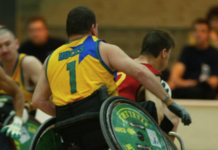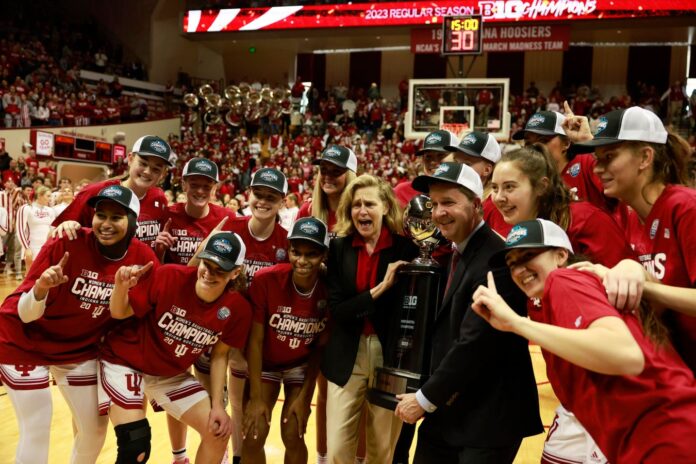BLOOMINGTON, UNITED STATES – 2023/02/19: Indiana University president Pamela Whitten celebrates with … [+] the womens basketball team which clinched the regular season B1G title after an NCAA womens basketball game against Purdue at Simon Skjodt Assembly Hall in Bloomington, Indiana. IU beat Purdue 83-60. (Photo by The Bloomingtonian/SOPA Images/LightRocket via Getty Images)
SOPA Images/LightRocket via Getty Images
Higher Education leaders have consistently touted athletics as key to a university’s brand. Media mentions overwhelmingly skew towards touting the successes of the athletics program; alumni and student conversations often center around how a team is doing; and creating awareness in a crowded landscape of competitors for a shrinking pool of high school graduates. It’s been a simple target to point to when it comes to creating some measurables for institutional success.
But last year, some colleges attracted a different kind of attention, putting leaders under the white-hot spotlight as protests on antisemitism, free speech and LGBTQ+ rights rocked many campuses.
“I’m not sure that I would be comfortable being a president today,” said Ted Mitchell, the former president of Occidental College and current president of the American Council on Education (ACE). “In addition to becoming exponentially more complicated, the job has also become more distant from the core of what a university does,” he said in a recent interview.
A University leader’s skills in negotiations and compromise are being tested as the academic year begins.
“The president in 2024 is someone who needs to be able to work with a large number of people in different groups, and, in many cases, navigate a pretty politically complex environment that has targeted higher ed,” said Dr. Kevin McClure, an associate professor of higher education at the University of North Carolina.
And those are just the non-athletics issues facing presidents this year.
When it comes to intercollegiate athletics, college presidents in all NCAA Divisions are fielding more questions, have fewer answers and face more uncertainty this coming year than before.
GLASSBORO, NJ – NOVEMBER 20: Middlebury College Panthers Charlotte Marks (1) holds the championship … [+] trophy while celebrating with teammates after defeating Johns Hopkins Blue Jays in the Division III Womens Field Hockey Championship held at Richard Wackar Stadium on November 20, 2022 in Glassboro, New Jersey. (Photo by Bill Streicher/NCAA Photos via Getty Images)
NCAA Photos via Getty Images
As I prepare to work with University leaders in my courses at the University of Pennsylvania this year, there are three things I’m going to ask them to focus on as presidents:
Pay attention to the toll this ambiguity is having on your staff’s job performance. The old performance expectations may no longer work. They need more grace and less pressure, as they often put way too much on themselves.
Consider whether the traditional benchmarking of your athletics spending to “peer” institutions is still valid. Even within the Big Ten and the SEC, the range of athletics budgets can vary tremendously. For example, compare Ohio State to Indiana University: both are long time members of the Big Ten Conference. The Buckeyes report a budget of $250 million; IU reports a budget of $144 million. It’s easy to talk about the high expectations for the Bucks, but how will the Hoosiers define success in today’s marketplace? In player retention alone, news reports surfaced that OSU had $10 million in NIL monies available to retain current players; there are no reports of Indiana’s collectives distributing any retention NIL payments to their football players. Even with the new revenues coming in from the 12-team College Football Playoff in 2024, Indiana may not be able to close the gap with Ohio State.
Most importantly, begin to communicate with your alumni, donors and fans about the turbulence, helping them understand what’s within and outside of your control. You will need their support and understanding more than ever, especially if you need to make significant changes in how your athletics program will respond to this new landscape.
This reckoning that college athletics is facing now may end up forcing the issue of rightsizing the athletics program at many schools. The campus budgetary pressures are real, and athletics spending will not slow down. It’s important to start those conversations now.
Having been a part of college athletics for almost my entire professional career, the one additional piece of advice I can offer University leaders is this: change is coming, whether you are ready or not. The best leaders always have a Plan B. What’s yours?
Source link : https://www.forbes.com/sites/karenweaver/2024/08/11/college-presidents-face-unprecedented-challenges-amid-athletics-and-campus-turmoil-in-2024/
Author :
Publish date : 2024-08-12 02:41:09
Copyright for syndicated content belongs to the linked Source.





















































